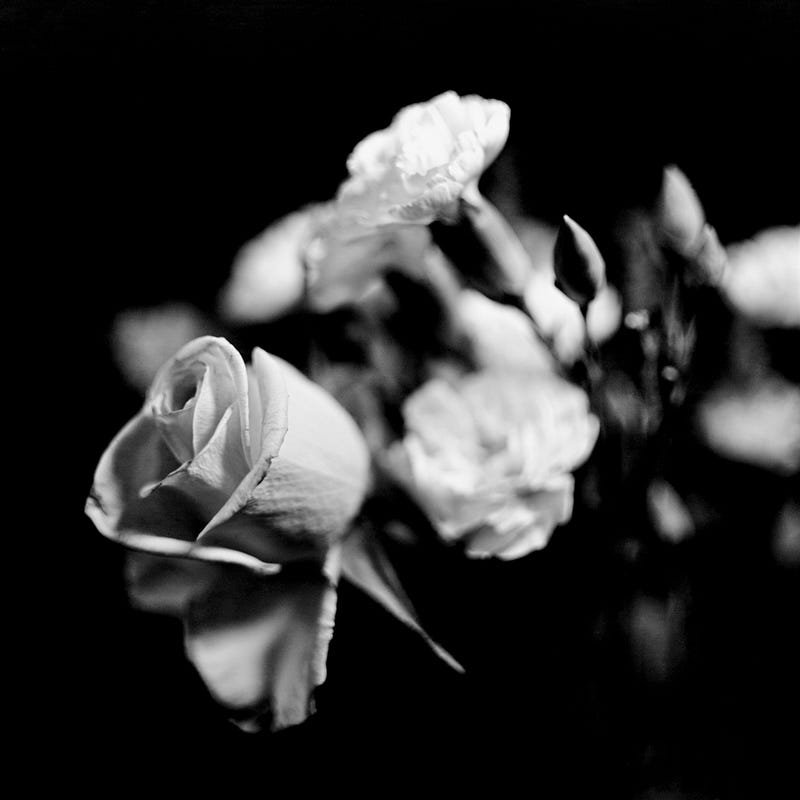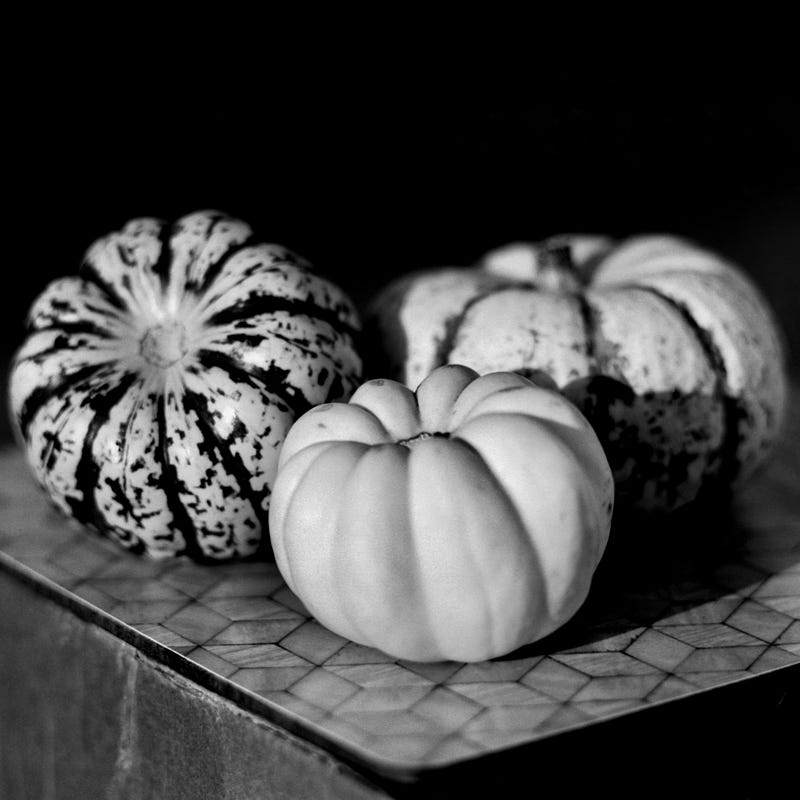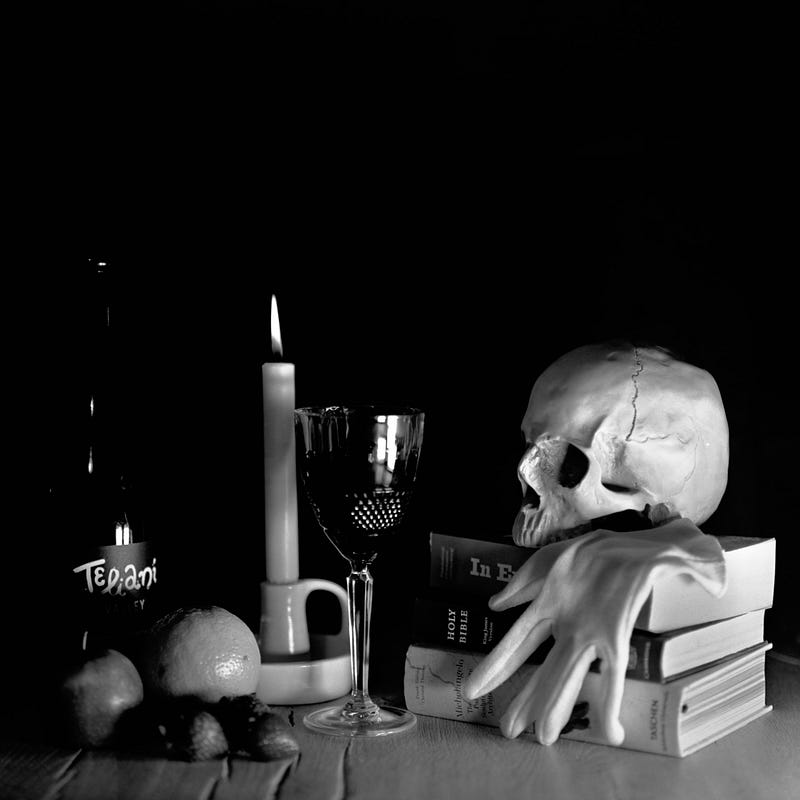5 Tips To Get Started With Still Life Photography on Film
- Author Michael Elliott
- Published September 11, 2023
- Word count 1,552

A rose by any other name. Black and white still lives of colourful objects can lend a rich and deep meaning to your work. Photo credit: Michael Elliott
5 Tips To Get Started With Still Life Photography on Film
Michael Elliott --- Fine Art Film Photographer-Flâneur and Londoner at Large
Still life photography is a genre that involves capturing inanimate objects, such as food, flowers, books, or toys, in a creative and artistic way. Still life photography can be a great way to practice your composition, lighting, and exposure skills, as well as to express your personal style and vision. However, shooting still life on film can be challenging, as you have less control and flexibility than with digital photography. You need to be more careful and deliberate with your choices of film, camera, lens, and settings, as well as with your development and scanning process. In this article, we will share some tips on how to take better still life photos on film, based on the advice of professional photographers and experts.
Subscribe to my weekly newsletter for lots more blog articles, photo features and more.
The Art of Creating Black and White Still Life: A Holistic Approach
The Art of Film Photography: Why It's Perfect for Creating Unique Wall Art
The Top 10 Film Cameras for Beginners: From Time-Honoured Classics to Hidden Gems
Tip 1: Choose the right film for your subject and mood
One of the most important decisions you need to make when shooting still life on film is what type of film to use. Different films have different characteristics, such as colour, contrast, grain, and dynamic range, that can affect the look and feel of your photos. For example, if you want to create a warm and cozy atmosphere for your still life, you might want to use a film that has rich and saturated colours, such as Kodak Ektar or Fuji Provia.

Kodak Ektar has a tendency to lean towards the warm tones so is perfect for those reddish bouquets of flowers. Photo credit: Michael Elliott
If you want to create a more dramatic and moody effect, you might want to use a film that has high contrast and fine grain, such as Ilford Delta or Kodak T-Max. If you want to experiment with different tones and textures, you might want to use a film that has low contrast and high grain, such as Lomography Color Negative or Kodak Tri-X.
Tip 2: Use a suitable camera and lens for your setup
Another important decision you need to make when shooting still life on film is what camera and lens to use. Different cameras and lenses have different features and capabilities that can affect the quality and style of your photos. For example, if you want to shoot close-up details of your still life objects, you might want to use a camera that has macro or close-focusing abilities, such as a Canon AE-1 or a Nikon FM2.

Pretty pumpkins all in a row. A combination of a long lens (180mm) and an extension tube allowed me to fully fill the frame with my subject while still maintaining enough separation between the elements and the background that a wide angle lens wouldn't have necessarily allowed for. Photo credit: Michael Elliott
If you want to shoot wide-angle shots of your still life scene, you might want to use a camera that has a wide-angle lens or a zoom lens, such as a Pentax K1000 or a Minolta X-700. If you want to shoot medium format photos of your still life, you might want to use a camera that has a larger negative size and higher resolution, such as a Fujica GL690 or a Kiev 60.
Tip 3: Experiment with different lighting sources and angles
One of the most crucial aspects of still life photography is lighting. Lighting can make or break your still life photos, as it can enhance or diminish the colours, shapes, textures, and shadows of your objects. Lighting can also create different moods and atmospheres for your still life photos, such as soft and romantic or harsh and dramatic. Therefore, you need to experiment with different lighting sources and angles when shooting still life on film.

A memento mori-style scene lit with high power LED panels from the right hand side and front, creating a moody atmosphere that befits the subject. Memento Mori #2 is available for purchase as a print. Photo credit: Michael Elliott
For example, if you want to create natural and soft lighting for your still life, you might want to use window light or diffused sunlight as your main light source. If you want to create artificial and hard lighting for your still life, you might want to use flash or studio lights as your main light source. You can also use reflectors or mirrors to bounce or direct the light onto your objects from different angles.
Tip 4: Compose your still life with care and creativity
One of the most fun and challenging parts of still life photography is composition. Composition is the arrangement of elements in your photo frame, such as objects, background, foreground, negative space, lines, shapes, colours, etc. Composition can affect the balance, harmony, interest, and message of your photo. Therefore, you need to compose your still life with care and creativity when shooting on film. For example, if you want to create a simple and minimalist composition for your still life photo1, you might want to use only one or few objects in your frame2, place them off-center3, use a plain background4, leave some negative space, and use contrasting colours. If you want to create a complex and elaborate composition for your still life photo, you might want to use many objects in your frame, place them symmetrically, use a textured background, fill the frame with details, and use complementary colours.
Tip 5: Develop and scan your film with care
The final step of shooting still life on film is developing and scanning your film. Developing and scanning your film can affect the final outcome of your photos in terms of colour accuracy, contrast, sharpness, and grain. Therefore, you need to develop and scan your film with care when shooting still life on film. For example, if you want to preserve the original colours and tones of your film, you might want to use a professional lab or a reliable home kit to develop your film, and use a high-quality scanner or a DSLR camera to scan your film. If you want to alter the colours and tones of your film, you might want to use different chemicals or temperatures to develop your film, and use different software or filters to edit your scans.
Conclusion
Still life photography is a rewarding and enjoyable genre that can help you improve your photography skills and express your creativity. Shooting still life on film can be challenging, but also rewarding, as it can give you more satisfaction and authenticity in your photos. By following these tips, you can take better still life photos on film and create stunning images that showcase your personal style and vision. Happy shooting!
If you enjoyed this, please do consider subscribing to my weekly newsletter. It has lots more blog articles, photo features and more.
Written by Michael Elliott --- Fine Art Film Photographer-Flâneur and Londoner at Large. If you enjoyed this, please do consider subscribing to my weekly newsletter. It has lots more blog articles, photo features and more.
Article source: https://articlebiz.comRate article
Article comments
There are no posted comments.
Related articles
- NOSEBLEEDS, NEIGHBOURS, AND NEW YORK: HEIDI'S ARTISTIC RESURRECTION
- Top-Tier Real Estate Videography in NV: Boost Your Sales with Stunning Visuals
- Find In-Home Senior Care Services Near You in Alabama: Expert Respite, Personal, and Dementia Care Solutions
- Elevate Your Entryway with a Statement Wall: Carved Wood Panels
- What Are the Comprehensive Senior Home Care Services in Prichard, AL for Trusted Respite and Dementia Care?
- Electronic Document Management System: Efficiency and Challenges in the Digital Age
- Best Air Conditioning Repair Service Queen Creek Florence Arizona
- How to Choose an Airport Transfer Service: A Guide for Stress-Free Travel
- Wirral Private Airport Transfers: Comfort, Convenience, and Class
- North Wirral Airport Transfers by Ventus: Trusted Travel from Coast to Terminal
- The Importance of Reliable Airport Transfer Services
- Find the Perfect Fireplace for Your Home
- The Pros, Cons, and Ethical Dilemmas of Employee Computer Activity Monitoring Software
- Over 40 and Ready to Mingle? Why Now Is the Best Time to Start Dating Again
- Whu buy an apartment in Manilva
- Best Electric Humidor: Top Picks for Effortless Cigar Storage in 2025
- They Tried Magic Mushrooms for Mental Health
- Sacred Balance: 5 Elements Chakra Healing with Mala Beads & Yantras
- Rooted in Heritage: The Rich Ranch Aesthetic with Antique Doors and Rustic Soul
- Carved Floral Barn Doors: A Shabby Chic Statement for Your Pantry & Laundry Room
- Confusion and Anxiety: Lincoln and the Days Before the Civil War
- How Website Maintenance & Security Protects Your Online Presence
- 5 Best Mortgage Brokers for Bad Credit UK
- 7 Best Mortgage Brokers in Derby
- Maximising Space and Efficiency: The Power of Dual-Purpose Fitness Machines
- Types of Eco Friendly Food Packaging
- Where Can You Find Lighting Stores in Brampton to Illuminate Your Home & Office?
- What Are the Top Real Estate Videography and Photography Services in CA?
- The Rise of Employee Performance Monitoring Tools: Balancing Productivity and Privacy
- Trends in Travel Security Technology
